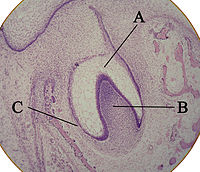
Photo from wikipedia
ObjectivesYAP (Yes-associated protein molecule) augments multiple processes known to be important for tumor progression and metastasis. Hence, the application of YAP as a targeted therapy for several malignancies has been… Click to show full abstract
ObjectivesYAP (Yes-associated protein molecule) augments multiple processes known to be important for tumor progression and metastasis. Hence, the application of YAP as a targeted therapy for several malignancies has been documented in the literature. Ameloblastoma being a locally invasive odontogenic lesion causes tissue destruction and presents with a great chance of recurrence. Based on these qualities, we hypothesized that YAP could exhibit increased expression in the odontogenic epithelium of ameloblastoma. Therefore, the objective of the present study was to evaluate the immunohistochemical expression of YAP in ameloblastoma and compare the immunoreactivity of YAP in ameloblastoma and dental follicle.Materials and methodsTwenty-four paraffin-embedded tissue blocks of ameloblastoma and dental follicle each were retrieved from the departmental archives. Immunohistochemical (IHC) staining was performed employing YAP antibody on 5-μm thick sections. The expression of YAP was reviewed on the peripheral lining of ameloblast-like cells and centrally placed stellate reticulum–like cells and was further graded as negative, weak, or strong. For data analysis, Chi-square test and Fisher’s exact test were applied.ResultsIn ameloblastoma, peripheral/basal cells exhibited strong expression for YAP in 12/24 cases and weak expression in the other 12 cases. Whereas, 20 cases of dental follicle presented negative expression and only four cases exhibited weak expression (p < 0.001). On statistical analysis, the differences in expression of YAP in stellate cells of ameloblastoma and dental follicle were found to be significant (p < 0.001).ConclusionYAP expression was strongly seen in ameloblastoma as compared to the epithelial islands of dental follicle. The neoplastic nature of ameloblastoma could be attributed to YAP molecule and it may play a possible role in tumor invasiveness.Clinical relevancePositive YAP expression in ameloblastoma and negative expression in the odontogenic epithelial islands of dental follicle insinuate that YAP could be responsible for the aggressiveness and local tissue invasion commonly encountered with ameloblastoma.
Journal Title: Clinical Oral Investigations
Year Published: 2018
Link to full text (if available)
Share on Social Media: Sign Up to like & get
recommendations!